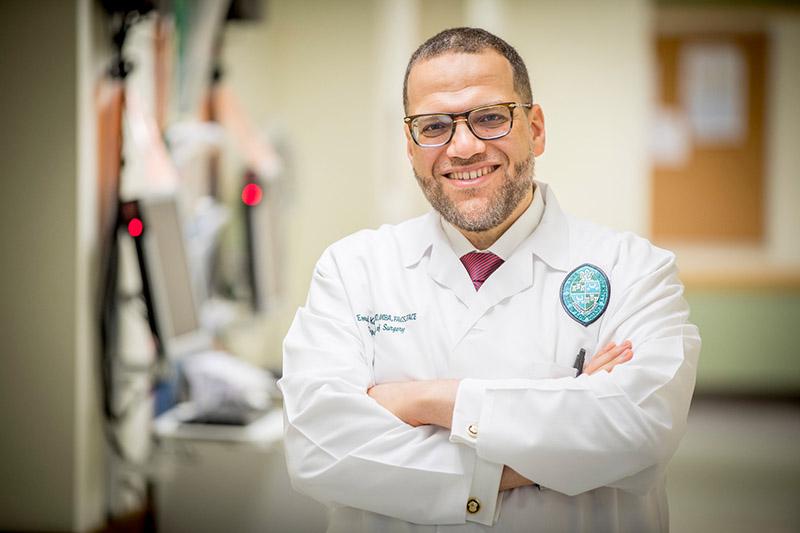Study compares outcomes of less- to more-aggressive surgeries for Papillary Thyroid Microcarcinomas
The incidence of thyroid cancer worldwide has increased over the last few decades. The majority of cases — approximately 80% — are papillary thyroid cancers, and of these, about 30% involve small tumors, no larger than 1 cm, also known as papillary thyroid microcarcinomas (PTMC).
In 2009, the American Thyroid Association (ATA) recommended thyroid lobectomy — a procedure that involves removing half the thyroid gland, the lobe that has the cancer — as a more conservative option to removal of the entire gland for PTMC patients.
In 2015, active surveillance was added to the ATA guidelines. "Active surveillance, or monitoring the nodule to make sure it doesn't increase in size or spread to the lymph nodes, is a valid option for many patients," said Emad Kandil, MD, MBA, professor and Elias Hanna Chair in Surgery. "For others, surgery is required."
The goal of this study was to analyze and compare the outcomes of PTMC patients who underwent extensive removal of the whole thyroid with those who underwent less extensive lobectomy to compare overall survival, cancer-free survival, and recurrence.
Kandil and his team used the National Institutes of Health SEER database (Surveillance, Epidemiology, and End Results Program) to retrospectively analyze the outcomes of 6,064 PTMC patients treated between 2000 and 2019. Of these, 3,652 underwent the more extensive total thyroidectomy, and 2,412 underwent partial lobectomy.
Of those patients who opted for total thyroidectomy, 82% were women, their tumor sizes were larger, and 12.3% had regional metastases, compared to 2.9% in the partial lobectomy group. Additionally, 0.4% of the total thyroidectomy patients had distant metastases compared to no distant metastases in the lobectomy patients.
"This tells us patients who underwent total thyroidectomy had more aggressive cancers overall," said Kandil.
When analyzing cancer recurrence, the data showed that although those who underwent total thyroidectomy had more aggressive tumors in general, their recurrence rate was one-third that of those who underwent less extensive surgery — 0.3% vs. 1%, respectively.
"There was almost triple the recurrence rate in the lobectomy group," said Kandil. "The group treated more aggressively has more advanced disease than those treated with less extensive surgery, but their cancer recurrence rate was lower."
There was also a slightly higher overall mortality rate in the lobectomy group — 8.1% vs. 5.2% in the total thyroidectomy group.
"This is very interesting data," said Kandil. "You start with two groups. One has more aggressive tumors than the other, but when you offer the more aggressive tumor more aggressive surgery they actually do better. These patients experienced less recurrence and better overall survival." (Overall survival refers to the percentage of people with a specific type and stage of cancer who have not died from any cause during a certain period of time.)
The data did not show a significant difference in cancer-specific survival between the two groups. (Cancer-specific survival refers to the percentage of people with a specific type and stage of cancer who have not died from their cancer during a certain period of time.)
What does this mean for patients? "We need to be very careful about offering patients with small cancers active surveillance or lobectomies," said Kandil. "I have a huge passion for minimal intervention, but the problem right now is we have no idea about which small cancers will progress and metastasize versus which will not. And currently, there is no reliable panel of genetic markers to help guide in our decision making."
But there is a non-surgical treatment option that could help. Radiofrequency ablation (RFA) is a procedure that reduces the size of tumors or nodules using radio waves. "RFA can shrink or literally kill the cancer in some patients," said Kandil, who has performed about 1,000 of these procedures over the past four years — the largest experience in the country. "It's not just a modality of treatment, but also a prognostic tool that could help to tell us which cancers are aggressive and which are not. Less aggressive tumors will respond more favorably to RFA and more aggressive tumors will not and maybe these are the patients who should undergo total thyroidectomy."
Data like these may help to change the ATA guidelines. In the meantime, Kandil and his team hope this study sends a message to physicians about being very careful before choosing active surveillance and less aggressive lobectomy as treatment options for PTMC.
"Of course, if you have an older patient with multiple medical problems, who is extremely sick and likely to die from some other health issue, then maybe active surveillance is a reasonable option. But thyroid cancer is most often diagnosed in middle-aged females. So until the guidelines are changed, the onus is on physicians to evaluate published data carefully and take it from there."
Dr. Kandil says this study would not have been possible without the contributions of Research Assistant Professor Eman Ali Toraih, MD, PhD, MSc, who was responsible for the gathering and biostatistical analysis of this data.
“This research provides a pivotal perspective in the debate surrounding optimal surgery for small thyroid tumors,” said Dr. Toraih. “Total thyroidectomy tangibly reduces recurrence rates and confers an overall survival advantage – remarkable gains for patients. And while the data reveals uncertainty regarding cancer-specific mortality benefits, total thyroidectomy appears no worse than less extensive options in this regard. These insights compel refinement of molecular markers determining who stands to gain most. But for many papillary microcarcinoma patients, these findings spotlight total thyroidectomy’s benefits warranting consideration when weighing treatment options.”

